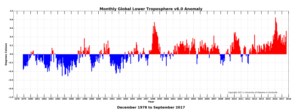by Anthony Watts, October 2, 2017 in WUWT
Warmest September in satellite temperature record
Boosted by warmer than normal water in the equatorial eastern Pacific Ocean that peaked in June and July, global average temperatures in the atmosphere rose to record levels in September, according to Dr. John Christy, director of the Earth System Science Center at The University of Alabama in Huntsville. Not only was it the warmest September on record, it was also the warmest month (compared to seasonal norms) in the 38-year satellite temperature record that wasn’t associated with an “officially recognized” El Niño Pacific Ocean warming event.

by Michael R. Rampino et al., October 2017, in Nature
Anomalous peaks of nickel abundance have been reported in Permian-Triassic boundary sections in China, Israel, Eastern Europe, Spitzbergen, and the Austrian Carnic Alps. New solution ICP-MS results of enhanced nickel from P-T boundary sections in Hungary, Japan, and Spiti, India suggest that the nickel anomalies at the end of the Permian were a worldwide phenomenon.
See also here and here
by McMaster University, October 2, 2017 in ScinceDaily
-
Life on Earth began somewhere between 3.7 and 4.5 billion years ago, after meteorites splashed down and leached essential elements into warm little ponds, say scientists. Their calculations suggest that wet and dry cycles bonded basic molecular building blocks in the ponds’ nutrient-rich broth into self-replicating RNA molecules that constituted the first genetic code for life on the planet.
by Australian Gov. Bureau of Meteorology, September 2017
Tropical cyclones in the Australian region are influenced by a number of factors, and in particular variations in the El Niño – Southern Oscillation. In general, more tropical cyclones cross the coast during La Niña years, and fewer during El Niño years.
Analysis of historical tropical cyclone data has limitations due to a number of changes in observing practices and technology that have occurred over time. With new and improved meteorological satellites our ability to detect tropical cyclones has improved, as has our ability to differentiate tropical cyclones from other tropical weather systems such as monsoon depressions, which in the past may have been incorrectly named as tropical cyclones. A particularly important change occurred in the late 1970s when regular satellite images became first available from geostationary satellites above the Earth’s equator.
See also here
La géologie, une science plus que passionnante … et diverse

